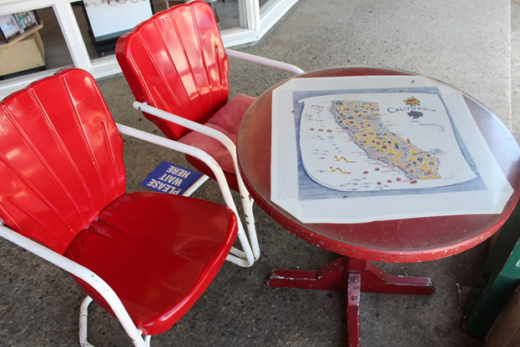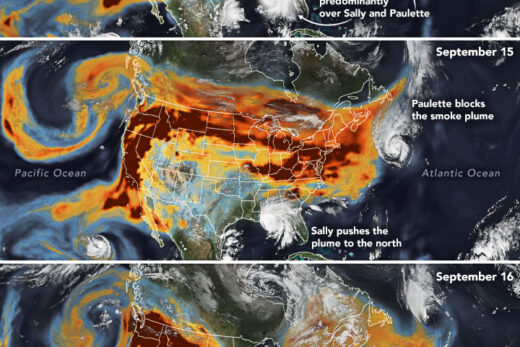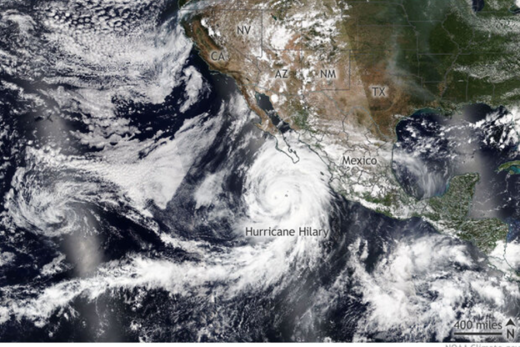Devastating earthquakes, floods, droughts, fires, and now a deadly virus: nature has thrown her share of disasters our way over the years. But there is one potential catastrophe that hasn’t received much attention lately. You don’t have to look too far to notice how volcanic eruptions have left their marks on southern and northern parts of the Golden State. They include fine examples of just about every type of volcanic activity. Most of these volcanic landscapes are remnants of an ancient geologic history that we consider in our publication. Still, some people might be surprised to learn that volcanic activity continues to simmer today and even threaten us with deadly, fiery catastrophes in locations scattered across the state.
This is certainly NOT the case around Los Angeles, where the city was destroyed in the fictional 1997 Hollywood film, Volcano, since there is no volcanic activity or threat near L.A. today. That movie’s makers had to refabricate the entire geologic dynamics of southern California to make their imaginary volcanic bomb. Here, we take you to northern California’s hot spots to survey the tremendous diversity of active and recently active volcanic landscapes that might remind you more of Washington State or Yellowstone.

We know that each natural hazard poses relative threats or dangers compared to other hazards. For instance, it is certainly true that the earthquakes we have researched in our publication and this web site represent greater potential threats to our state than volcanic eruptions. (It is likely that California will suffer at least one deadly, devastating, and possibly catastrophic quake within the next 30 years.) And we have reported on the deadly fires that have terrorized and even destroyed California communities in recent years. We also recognize that most Californians do not suffer from natural disasters of such frequency and severity as the less fortunate who live in less developed regions of the world. But this story offers another chance for us to appreciate the simultaneous beauty and danger produced by the awesome natural systems and cycles that define our living Earth. Here, we celebrate advancements in science that help prove how our knowledge of nature equals power in this latest version of beauty and the beast.

This story does not focus on the parts of southern California exhibiting volcanic landscapes that were either recently formed in geologic time or remain active today. Some of these weathering in the Mojave Desert include a chain of ancient volcanoes from Barstow to Amboy. Pisgah and Amboy cones are only thousands of years old and sit atop a variety of lava flows, channels, and caves; at first glance, they appear so fresh as if they could have erupted a few years ago, until you examine more closely. Five young pumice and obsidian domes south of the Salton Sea have erupted among the transform faults and pull-apart basins that help define the thin crust of the Imperial Valley. Gurgling mud pots and active mud volcanoes remind us why this area is listed as one of the higher volcanic eruption threats in the state, as it produces its share of geothermal energy. The Coso Volcanic Field around the southern Owens Valley (including conspicuous Red Hill cinder cone and Fossil Falls adjacent to Hwy 395) and Ubehebe Craters in northern Death Valley are less likely threats also surveyed in our publication but also too far south for this story.

Here, we consider northern California’s active volcanic regions that earth scientists and geophysicists consider to be high or very high risks. We can now lean on research being done by some of the best geologists and volcanologists at the United States Geological Survey’s Volcano Observatory. These experts recognize the same general volcanic regions we have been researching and reporting on during our project’s more than 20 years. They confirm that, though California’s volcanoes are distant from major cities, nearly 200,000 people are at risk each day, and many millions more pass into and through their sprawling danger zones each year. We are also reminded how these active volcanoes have built some gorgeous and even stunning landscapes that beckon us to reconnect with nature.

Long Valley Volcanic Region and Mammoth Mountain
Riding the ski lifts up Mammoth Mountain, you can look down into the giant bowl below that is Long Valley Caldera. This massive caldera formed nearly 800,000 years ago when a cataclysmic eruption blasted volcanic ash and cinder that would settle in thick layers on surrounding landscapes, while it blew traces of the catastrophe as far as the Great Plains, before collapsing. It is just part of what geologists have labelled the Long Valley Volcanic Region that has been active for about 4 million years, leaving imprints on the landscape that stretch for many more miles.

For instance, Mammoth Mountain is a series of accumulated and overlapping lava domes that date back about 50,000-100,000 years and it is considered a moderate threat. But today’s active hot springs, fumaroles, and volcanic gas emissions remind us that a turbulent magma chamber waits shallow below the surface for its next return to the stage. The most recent volcanic activity around the base of Mammoth Mountain is only about 8,000 years old.

This region stretches north more than 20 miles toward Mono Craters and into Mono Lake, where the most recent eruption was only about 300 years ago. This is why geologists estimate the Long Valley Volcanic Region to be at very high risk, with a 22.5% chance of experiencing an eruption of some sort in the next 100 years. And that is most likely to occur somewhere around the young Mono Craters that experienced eruptions only about 680 years ago.

In 1980, curiously during the infamous Mt. St. Helens explosions in Washington, ground swelling was measured and a series of moderate earthquakes rolled through the region, doing some damage, as a magma chamber was measured squeezing its way toward the swelling surface. That eruption never saw the light of day, but officials have made sure there is more than just one emergency exit route off Mammoth Mountain, just in case.





In the next two images, we will take a brief break from our active, high risk volcanoes to show a peculiar ancient volcanic landscape (Sutter Buttes) that pops up from the Sacramento Valley.


Clear Lake and Geysers Volcanic Area
A volcanic region around 100 miles north of San Francisco stretches from The Geysers north into Clear Lake. Geophysical surveys reveal a mass of partially molten rock below this region with a larger magma chamber below that. This region is dotted with numerous hot springs and fumaroles (discharging steam) that start in our most famous wine country and stretch north from Sonoma and Napa Valleys all the way to Clear Lake. The hot springs start as rain water that seeps deep into hot rocks until it heats under pressure (more than 350 degrees F at one mile deep) and finally erupts to the surface.

The Geysers region’s natural fumaroles originate in shallow cavities only a few hundred feet deep. A host of geothermal companies drilled into much deeper reservoirs up to two miles until they tapped the sources dry by 1990. There is still enough activity to boil residual heat water that has seeped through underground fissures, especially in the Mayacmas Mountains. The Geysers Resort and geothermal power plants are east of Cloverdale. These wells are some of the largest geothermal energy producers in the world, producing enough energy for a city of more than 500,000 people with the potential to send power to up to 900,000. The lack of corrosive chemicals in the dry steam contributes to a more efficient energy source. You will find California’s Old Faithful Geyser southeast of this area, near Calistoga.

There may be only about 1,000 geysers on Earth that episodically discharge water and steam. California’s Old Faithful is what remains of more than a dozen wells in the area that were pricked by the 1930s to release fountains of water and steam to attract tourists. Here again, groundwater accumulates and gets superheated up to 350 degrees F until it erupts under pressure. Old Faithful’s cycle may shorten to only about every 5 minutes after heavy winter rains, but can lengthen to every hour or so during dry autumns. It has been touted as one of only three “faithful” geysers on Earth.

The north end of this volcanic field is around Clear Lake. During its roughly two million years of activity, most eruptions here have not been particularly violent, though eruptions through the lake around 11,000 years ago involved flash vaporization of water. The most notable landmark is 300,000-year-old Mt. Konocti, with its five peaks up to 4,300 feet asl and the nearby younger shoreline craters and cinder cones that date back to those more recent flash eruptions. USGS scientists continue monitoring gas emissions, the dozens of annual seismic events on southern flanks of the lake, and thousands of earthquakes that shake the entire region each year.

Left behind are a wide variety of rocks to admire. Chemically-intermediate andesite dominates, but with occasional smatterings of rhyolites and basalts. Pyroclastics and lava flows cover hundreds of square miles in the Coast Ranges’ Sonoma, Howell, and Mayacmas Mountains, including the broken rhyolites of Mount Saint Helena.


Medicine Lake and Lava Beds
Medicine Lake is located in far north-central California, just south of and adjacent to Lava Beds National Monument. It is part of the Cascades system, erupting from magma that forms deep below the surface as the Gorda oceanic plate is subducted below the North American continental plate in the Cascadia Subduction Zone. Underplating is another term often used to describe the denser ocean plate grinding into and incorporating pieces of the overriding continental plate as it is thrust under it. We examine this plate tectonic geology more thoroughly in our publication.

This Medicine Lake region has a wider assortment of eruptions and rock chemistry compared to most other great Cascade volcanoes. The voluminous foundation of Medicine Lake volcano was built during approximately 500,000 years of effusive eruptions that poured out extensive runny lava flows, Hawaii style (containing abundant darker, heavier iron and magnesium with very high melting points). However, those older basalts grade toward more recent rhyolitic (felsic), viscous eruptions that have been more violent. Seven of the ten eruptions during the last roughly 5,000 years have included ash clouds and thick, glassy lava flows and those include Little Glass Mountain and Glass Mountain around 1,000 years ago. Medicine Lake is listed as a high risk volcano.

The top of a much larger volcano collapsed up to 5 million years ago, leaving a giant caldera to be filled with younger lava flows. Today’s 8X14- mile caldera containing Medicine Lake is labelled a water-filled collapse basin. Partially molten rock remains below the volcano, fueling geothermal activity.

The many types of eruptions from Medicine Lake during the last 500,000 years have also spread a wide variety of volcanic flows across Lava Beds National Monument that include cinder and spatter cones and nearly 700 lava tube caves. Since geophysicists estimate there is about a 1% chance that there will be an eruption within the next 30 years, it is considered a relatively high risk region.


We will now take another brief break from our more hazardous, active volcanoes to view ancient volcanic landscapes common to the Modoc Plateau. You will find them between and east of the Cascades’ Shasta and Lassen.


We now turn our attention to the two most magnificent and majestic California volcanoes (Shasta and Lassen), both of the southern Cascades and both listed as very high risk.

Mt. Shasta
It is the giant ice- and snow-covered dome that dominates the horizon of nearly every north-central California landscape. It demands your attention whether you are traveling north from Redding or south from Oregon. It is California’s quintessential volcanic mountain and it means business.

Shasta is a classic composite or stratovolcano that was built by a series of eruptions from magma chambers forming in that previously-mentioned subduction zone, as the continental North American plate slides over the oceanic Gorda Plate. Continental crust is melted and incorporated into the magma as it rises toward the surface, producing relatively felsic (rich in light-colored silica, poor in darker and heavier iron and magnesium), viscous eruptions that can be catastrophic. At nearly 14,170 feet above sea level, the current summit has grown to replace a cataclysmic collapse and record-shattering landslide that devastated Shasta Valley toward the north more than 300,000 years ago.

More recently, the smaller Shastina dome (attached to the upper west slope of Shasta) and the steep, dramatically-conic Black Butte (pointing up next to Interstate 5) formed during eruptions about 11,000 years ago. Bursts of steam and ash may have been emitted just a few hundred years ago, but scientists date the last official eruption at about 3,000 years. Average eruption intervals of about 800 years over recent geologic history suggest about a 3.5% chance of an eruption in the next 30 years from a deep mass of partially molten material.


Geologists inform communities and officials around Shasta and Lassen of potential hazards as they use seismometers and GPS receivers to measure seismic activity and surface deformations to assess future risks. Think of the cataclysmic eruptions from similar composite volcanoes around the world, particularly around the Pacific Ring of Fire. So, if you like to tempt fiery terror that includes killer glowing gas clouds and lahars, this massive volcano’s for you, as it is considered a very high risk.

Most locals are more affectionate, knowing that wherever and whenever they see a big white cone reaching to the sky, it has to be Shasta. They also observe how this 5th tallest mountain peak in California has influenced local air flow patterns and other weather, such as by forcing air to rise up its slopes to drop the moisture that helped build today’s shrinking glaciers, and how its microclimates support the diversity of plant communities and ecosystems that have adapted to each elevation on each side of the volcano.

Lassen (Formerly Mt. Tehama)
Lassen marks the southern end of the great Cascade volcanoes fed by magma chambers formed within the behemoth Cascadia Subduction Zone previously mentioned. It is also an imposing landmark from many different locations that range from near Shasta, to much of the Sacramento Valley, to the northern Sierra Nevada. Located east of Redding, it looms closer to larger population centers than Shasta and is also listed as very high risk for very good reason.

Though its eruption from 1914-1917 was considered small to moderate by Cascades standards, it belched out the storied 30,000-foot mushroom clouds of ash that were carried and deposited as far as 280 miles east by prevailing winds and viewed by awestruck residents in the Sacramento Valley and beyond. This fiery drama included the apocalyptic pyroclastic flows and lahars, though this time they were relatively smaller than more legendary eruptions from notorious Pacific Rim volcanoes. This recent eruption and the natural beauty that defines Lassen solidified it as one of our National Parks, though it is not as large or overwhelming as a Yellowstone or Yosemite.

Only two other recent eruptions near what is called Lassen Volcanic Center included Lassen’s Cinder Cone about 345 years ago and at Chaos Crags about 1,100 years ago. However, there have been hundreds of various kinds of explosive eruptions throughout the region within the last million years. Many of Lassen’s features sit within what was (more than 300,000 years ago) a much larger andesitic stratovolcano now known as Mt. Tehama or Brokeoff Volcano. It reached to about 11,000 feet and was more voluminous than Shasta before its collapse, leaving only remnants around today’s Lassen that include Brokeoff Mountain. What we see today is one of the world’s largest dacite lava domes that has squeezed up in place of Tahama’s collapse (making it unique among Cascade volcanoes). As might be expected, a deep mass of partly molten rock that fuels today’s geothermal activity lurks below Lassen. This activity includes accessible and colorful fumaroles, hot springs, and gurgling hot mud pots that attract ecotourists and geology buffs. You don’t have to imagine Yellowstone while walking through Bumpass Hell or more easily accessible Sulphur Works.

As with Shasta, seismometers and GPS receivers are measuring any earthquakes and surface deformations that may warn of future eruptions. With about a 0.5% chance of erupting each year, Lassen is listed as a very high risk volcano. The peak stands high over the surrounding landscapes, but it is usually accessible by July to the hardy hiker after winter snow packs have melted down.

As with Shasta, Lassen represents a formidable barrier that reroutes air flow patterns and forces air masses to rise over it. When these air masses cool and condense, they drop copious moisture on the slopes. Subsequent runoff feeds streams that cascade down to lower elevations, nourishing a variety of lush, stunning ecosystems that attract wildlife and more ecotourists.

All of the northern California volcanic areas examined here (except for the Sutter Buttes photos) are considered active volcanoes with molten or partially-molten materials lurking below, while generating volcanic activity at the surface. We hope you have enjoyed learning about these colorful but threatening geologic landscapes that combine to decorate the Golden State. You can find more details about California volcanoes in various publications that have appeared over the years and are listed in our publication. They include stellar, exhaustive works, from general books on the geology of California to handy roadside geology guides. If you want to learn even more about California’s volcanoes and their threats, go to the world’s leading scientists at the USGS Volcano Observatory, who helped inform this story and brought more clarification to some of the information we have presented in this project during its more than 20 years: https://www.usgs.gov/observatories/california-volcano-observatory
For now, we appropriately end this explosive story by completing our colorful tour of Lassen Volcanic National Park.























